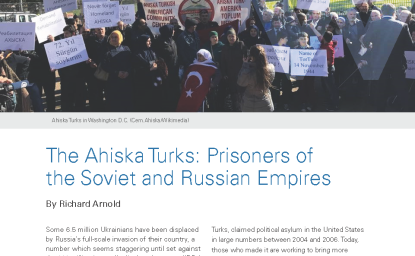226. The Plight of the Roma in Eastern Europe: Free At Last?

Roma arrived in Europe around the 13th century, after migrating from Northern India through Persia to Armenia and into Europe. They then spent three centuries - beginning around the 15th century and ending with the establishment of the modern Romanian state in 1864 - enslaved in what is now modern Romania and Moldova. The end of slavery led to the significant migration of the Roma from the Romanian/Moldovan states deeper into the Balkan peninsula.
In much of the rest of Europe, the story is the similar. Romani experience throughout most of these centuries was marked by pronounced social exclusion, expulsion, or arrest solely on the basis of their ethnicity. In Spain, King Ferdinand VI ordered the mass race-based imprisonment of all Roma in Spain in 1749. During the "enlightened" reign of Maria Theresa (1740-80) in the Habsburg Empire, Roma were subject to banishment if they did not submit to a master, and children were forcibly removed from Roma homes for "re-education" and apprenticeships.
In the long list of the Roma people's mistreatment and discrimination throughout history, there were, however, certain "exceptions" which should be acknowledged. Some places were less intolerant, or "less bad," than others, e.g., there was relative tolerance under the decentralized rule of the multi-ethnic Ottoman Empire, and a romanticized view of Roma in some Hungarian and Russian literature (a la the "noble savage"). These exceptions are few and far between.
What explains the Romani experience in Europe before the 20th century? Partly, the capacity for man's inhumanity to man and the tendency to discriminate against those who are "different" or "distinct" from the majority. Roma were dark-skinned, had an unusual language, customs and dress; Roma were not Christians when they first arrived in Europe and were consequently targeted as heathens; they were also often confused with other groups - Egyptians, Tatars, Turks - and they were suspected of being "Turkish" spies.
On the brink of modernity and the two World Wars of the 20th century, however, Romani suffering reached new bounds, as people devised ever more ingenious ways to denigrate their fellow human beings. This piece attempts to shed light on the murky and tragic history of the Romani people in the 20th century and to point out recent, hopeful developments, which could finally improve this community's outlook for the 21st century.
The "Porrajmos" (Devouring): Romani Experience During the Holocaust
During the 1920s and 1930s, institutionalized racism against Roma took on an increasingly virulent form. Policies similar to those instituted against Germany's Jews were also implemented against Roma: race-based denial of the right to vote; selection for forced sterilization; loss of citizenship; incarceration in work or concentration camps; and, ultimately, deportation to, and annihilation at death camps. During the war itself, Roma were targeted for death by the Nazis based on their ethnicity.
The Holocaust, known in Romani as Porrajmos ("The Devouring"), was the single most defining experience for the Roma in the 20th century. At least 23,000 Roma were brought to Auschwitz. Almost all of them perished in the gas chambers or from starvation, exhaustion, or disease. Some Roma also died at the hands of sadistic SS doctors, like Joseph Mengele, who particularly liked to experiment on Roma. On the night of August 2nd and 3rd, 1944, the order was given to liquidate the Romani camp at Auschwitz-Birkenau. In a single evening, 2,897 Romani men, women and children were killed in gas chambers. Approximately 25,000 Roma from Romania were deported en masse to Transnistria in 1942; some 19,000 of them perished there. Scholars estimate that, in Croatia, 90 percent of the Romani population was murdered.
What is known about the Romani experience during the Holocaust is far exceeded by what has yet to be uncovered. Although it has been very difficult to estimate both the size of the pre-war European Romani population and war-time losses, some scholars put the size of the Romani population in Germany and German-occupied territories at 942,000 and the number of Roma killed during the Holocaust at half a million. After World War II, the post-Nazi German Government strongly resisted redressing past wrongs committed against Roma, seeking to limit its accountability. In addition, Roma have been discriminated against in court proceedings and their testimony has often been viewed as, a priori, unreliable. As a telling example, the first German trial decision to recognize that Roma as well as Jews were the victims of genocide during the Third Reich was not held until 1991.
Roma Under Communism: Protegees and Beneficiaries?
With the end of WWII and the fall of the Iron Curtain over Eastern Europe, Roma, the majority of whom resided in the region, were faced with a new kind of overlord - a superficial benefactor with an iron grip, thinly disguised by seemingly egalitarian rhetoric. Some scholars suggest that the communist overlords were "good" to the Roma, arguing that Romani benefited from "positive discrimination" by receiving housing, schooling, and free medical care. In fact, the "benefits" the Roma received from communism are often overrated, while the hardships they suffered are often overlooked - forced assimilation; segregation in housing and employment; repression of the Romani language and repression or manipulation of Romani cultural organizations; confiscation of private property including horses and wagons; and, among others, child abduction and forced sterilization. These matters are sometimes ignored by those who argue that the communist system, which was notoriously disastrous for everyone else, was somehow, inexplicably, good for the Roma. Despite these hardships, it must be acknowledged that police states seem to have done a better job of protecting Roma from the kind of widespread, racially motivated violent attacks to which these people have been subjected during the first post-communist decade.
The Record in Non-Communist States
Romani experiences in Western Europe have not been significantly better than the communist record. Roma were politically and socially marginalized and were repeatedly made the victims of extraordinary social prejudice. In Switzerland, Romani children were stolen from their families by the state. Norway and Sweden have acknowledged that Roma were among the victims of forced sterilization for decades. Meanwhile, in the United States, Roma continue to be the subject of pernicious stereotyping by the media and sometimes the victims of racial profiling by law enforcement agencies.
The First Post-Communist Decade: A Mixed Record
The fall of communism in Central Europe has created opportunities for Roma that have never before existed: in particular, opportunities to represent themselves in political life; opportunities to protect and promote their language and culture; and opportunities to resume the development of their ethnic identity a process that was devastated by the Holocaust and then frozen in time by communism.
Today, Roma are dispersed throughout all European countries. Taken together, there may be 8-10 million Roma in Europe, with large concentrations in Central, Eastern, and Southern Europe. Even a low-ball estimate of the number of Roma in Europe exceeds the respective populations of Albania (3,364,571), Bosnia-Herzegovina(3,482,495), Croatia (4,676,865), Cyprus (754,064), Denmark (5,356,845), Estonia (1,408,523), Finland (5,158,372), Ireland (3,632,944), Latvia (2,353,874), Luxembourg (429,080), Macedonia (2,022,604), Malta (381,603), Moldova (4,460,838), Norway (4,438,547), Slovakia (5,396,193), and Slovenia (1,970,570), or in other words, 1/3 of the states of the OSCE (CIA World Factbook 1999, http://www.odci.gov/cia/publications/factbook/index.html).
In many countries, Roma are reported to be the fastest growing ethnic group. For example, the 1992 Bulgarian census indicated that 23.2 percent of the Romani minority was under the age of nine, compared to 12 percent of the ethnic Bulgarian population. This high birth rate has generated a cottage industry of relatively speculative and sometimes alarmist news stories focused on national demographic trends. In Slovakia alone, a recent article posited that, by the year 2060, the Roma will form a majority of the national population.
While creating numerous openings for representation and identity-building, the first post-communist decade has also allowed prejudice against Roma to flourish as well as create new threats, most of which are entrenched in the region's communist legacy. First and foremost, the Roma have experienced an extraordinary wave of racially motivated violence. This violence has ranged from attacks by non-state actors such as mobs, to attacks by state organs such as the police. In Romania alone, after the fall of the Ceausescu regime, more than 30 Romani settlements were set on fire during mob attacks. On the day Romania joined the Council of Europe, September 20, 1993, three Roma were killed, fourteen houses set on fire, and four houses destroyed in the village of Hadareni. For all practical purposes, there has been no real accountability for these crimes and, in some cases, there is evidence of police complicity in these attacks.
A new trend fostered by the fall of communism and the subsequent amendment or rewriting of national constitutions has been the denial or loss of citizenship for Roma. This is largely a problem that has arisen in newly independent countries such as the Czech Republic, Croatia, Macedonia, and Slovenia. When the Czechoslovak Federation dissolved on January 1, 1993, for example, the Czech Republic implemented one of the most narrowly crafted citizenship laws of any of the 21 newly independent states of the OSCE community. Thousands of Roma who had been long-term or life-long residents of the Czech lands - former Czechoslovak citizens - were left stateless and told to go to Slovakia. In 1999, the Czech law was finally amended to resolve this problem. Implementation of the new law, however, has been deficient and there are Roma in the Czech Republic who have not yet benefited from the changes.
De facto segregated education is another problem attributed to the communist legacy. There are two variants of this problem: segregation that results from channeling Roma into special schools for the mentally handicapped, regardless of the lack of any real handicap; and the American version, which results from separate housing locations for the majority and the minority. Similar discrimination has occurred in public places, such as restaurants and swimming pools, and in the workplace.
Responses and Surprises for the Coming Decade
What has been the response to these human rights violations? Frankly, government programs have been a day late and a dollar short every single step of the way. There is not one government that has begun to devote the necessary resources, energy and political will that Romani issues demand.
To be fair, I must acknowledge that there are a handful of dedicated public servants sprinkled sparingly throughout this region who are working tirelessly, under the most difficult circumstances, to improve respect for the human rights of the Romani minorities in their countries - Petr Uhl and his staff in the Czech Republic, Pal Csaky and Vincent Danihel in Slovakia, Peter Eckstein Kovacs in Romania, to give a few examples. But they are swimming against the stream. The task of dragging these countries into the 21st century will be fulfilled not by these few scattered individuals but by the increasingly well-organized Romani civil rights movement.
Roma increasingly speak the language of political and civil rights. In the early 1990s, both governmental and Romani representatives tended to speak of Romani problems as "social and economic" - both sides acknowledged the high unemployment rate among Roma. This kind of rhetoric very much reflected the success of fifty years of communist indoctrination. Today, although government officials still routinely deny that Roma face human rights violations, Roma demonstrate a new understanding that unremedied work place discrimination and de facto segregated schools are the true cause of high Romani employment. This new understanding has carried over into the community's ability to self-organize. A good example comes from Bulgaria: in 1999, some 70 Romani non-governmental groups banded together, wrote a policy platform for Roma that included a demand for anti-discrimination legislation, and then effectively forced the Bulgarian government to adopt their platform instead of the watered-down version drafted by the government.
Romani NGOs also demonstrate an ever-growing, trans-national element and a rising level of expectations. Increasingly, Roma speak on behalf of their co-nationals. Consequently, when the municipal authorities in Usti nad Labem, the Czech Republic, build a wall to segregate Roma from non-Roma, Roma nationals from Texas to Transcarpathia sent out protest letters. As a result, the national authorities in Prague, looking for a face-saving way out of this public relations disaster, not only had to find a solution that would be accepted by Romani Czechs in Usti, they had to deal with the political pressure created by Roma from all over Europe and North America. One of the most fascinating aspects of this growing transnational organizing has been and continues to be the role played by the Internet.
Of particular interest as up-and-coming issues, are two areas of Romani activism: first, Romani political organization, with a view to increasing their participation in the electoral process as both voters and elected officials; and second, efforts to promote the Romani language and culture. In ten years, there will be a generation of twenty-something Romani activists coming of age who have never lived under communism. Little Hungarian Romani first graders, whom the Hungarian Minister of Education said made up 30 percent of the last year's first grade class - in fifteen years, those little first graders will be voters.
Erika Schlager spoke at an EES Discussion on January 24, 2001. The above is a summary of her presentation prepared by Sabina Crisen, EES Program Associate. Meeting Report #226.
Author

Global Europe Program
The Global Europe Program is focused on Europe’s capabilities, and how it engages on critical global issues. We investigate European approaches to critical global issues. We examine Europe’s relations with Russia and Eurasia, China and the Indo-Pacific, the Middle East and Africa. Our initiatives include “Ukraine in Europe”—an examination of what it will take to make Ukraine’s European future a reality. But we also examine the role of NATO, the European Union and the OSCE, Europe’s energy security, transatlantic trade disputes, and challenges to democracy. The Global Europe Program’s staff, scholars-in-residence, and Global Fellows participate in seminars, policy study groups, and international conferences to provide analytical recommendations to policy makers and the media. Read more

Explore More
Browse Insights & Analysis
Dr. Maurice Jackson: The Sounds of Resistance Throughout History


